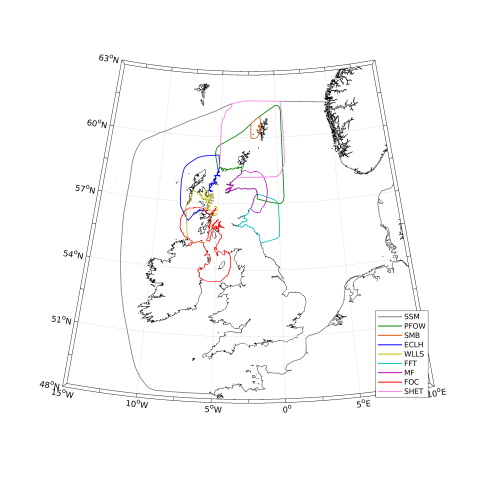The Scottish Shelf Model
Marine Scotland has led the development of a suite of hydrodynamic models of Scottish continental shelf waters, the Scottish Shelf Model (SSM). These models have a wide range of marine science and policy applications. The initial model development was contracted out by the Scottish Government to CH2M Hill who worked on the project in conjunction with the National Oceanography Centre (NOC), Liverpool. The project was completed at the start of 2016. Marine Scotland Science (MSS) is now the custodian of the SSM and is continuing to develop and integrate the models with their existing hydrodynamic models. The models, and the model outputs, are available to the wider marine science community.
The model domain covers the Scottish continental shelf at relatively high resolution but also covers most of UK waters, the North Sea and the English Channel. The domain extends from approximately 48° - 62° N and 13° W - 13° E. In addition to this large domain Scottish Shelf Model, a number of smaller domain sub-models have been developed, covering areas of interest to specific socio-economic sectors such as aquaculture and marine renewable energy. These sub-models have a higher spatial resolution, which is necessary to adequately understand the complex physical processes within these areas.
The figure shows the domain of the SSM and the sub models which are fully integrated. The main outputs available are from a one year model run using climatological forcing (a 25 year average) which represents an `average' year.
Please use the links below to find out more about the models and their applications.

| Title |
Updated date |
|---|---|
| Salmon Parasite In Linnhe, Lorn, and Shuna (SPILLS) | 09/06/2023 |
| The Wider Loch Linnhe System Model | 23/08/2022 |
| The wider domain Scottish Shelf Model | 21/07/2022 |
| The St Magnus Bay Model | 04/03/2022 |
| The East Coast of Lewis and Harris Model | 04/03/2022 |
| The Pentland Firth and Orkney Waters Model | 04/03/2022 |
| The Firth of Clyde Model | 04/03/2022 |
| Biological connectivity and fish larvae | 04/10/2021 |
| Scottish Shelf Model Applications Summary | 04/10/2021 |
| Oil spill and pollutant trajectory modelling | 04/10/2021 |
| General flow characterisation | 04/10/2021 |
| Renewable energy impact assessment | 04/10/2021 |
| Aquaculture | 04/10/2021 |
| Assessing Scotland's Seas | 04/10/2021 |
| The Shetland Model | 01/02/2021 |
| The Moray Firth | 25/02/2020 |
| Scottish Shelf Waters Reanalysis Service | 30/01/2020 |
| Scottish Shelf Model Community | 18/10/2018 |
| Scottish Shelf Model Integration | 25/09/2018 |
| Finite Volume Community Ocean Model | 25/09/2018 |

